

SUBSCRIBE TO OUR FREE NEWSLETTER
Daily news & progressive opinion—funded by the people, not the corporations—delivered straight to your inbox.
5
#000000
#FFFFFF
To donate by check, phone, or other method, see our More Ways to Give page.


Daily news & progressive opinion—funded by the people, not the corporations—delivered straight to your inbox.
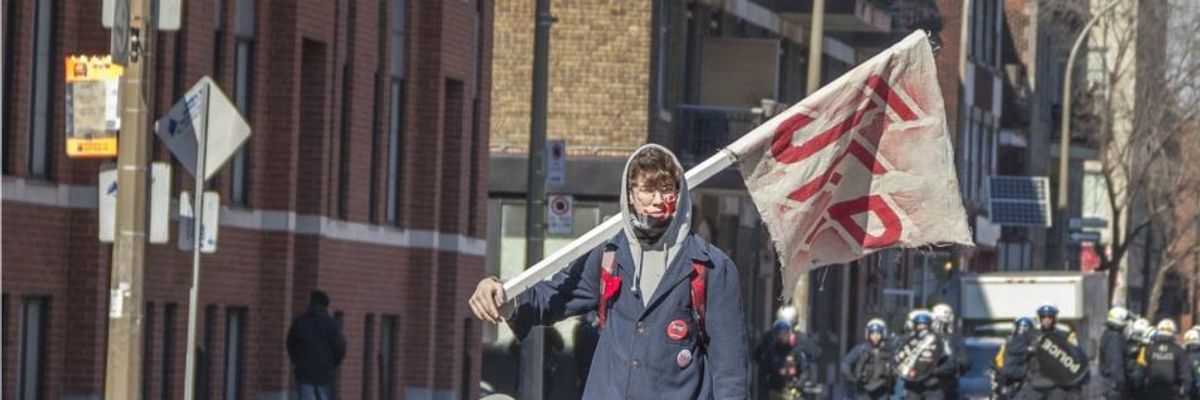
"Student striker" (Photo: AJ Korkidakis/Ricochet)
The weather report had called for "snow/rain," but instead the clouds parted and the largest demonstration in Quebec since the student strike of 2012 was bathed in the sunny glow of springtime in Montreal.
In Square Victoria, a park in the heart of Montreal's financial district, each metro brought a new surge of people and the place was soon packed, with the crowd overflowing into several side streets.
The weather report had called for "snow/rain," but instead the clouds parted and the largest demonstration in Quebec since the student strike of 2012 was bathed in the sunny glow of springtime in Montreal.
In Square Victoria, a park in the heart of Montreal's financial district, each metro brought a new surge of people and the place was soon packed, with the crowd overflowing into several side streets.
Over 130,000 students were on strike across Quebec on Apr. 2, and according to the Association pour une solidarite syndicale etudiante, the crowd in Montreal reached around 75,000 at its peak. Based on my calculations, that's a reasonable estimate. Other media outlets reported a number of 25,000, attributing it to police scanners, but that may have been prior to the demonstration's peak.
* VIDEO: #Manif2Avril, the fight against austerity in pictures
* EXPLAINER: Will Quebec's student movement opt for a spring strike or a strategic fallback?
Alongside students there was a strong labour presence, with public sector employees joining Montreal's firefighters, labour federation Confederation des syndicats nationaux and dozens of other unions in the streets. McGill University's law department was on strike for the first time in the history of that institution, and their banner was greeted with cheers wherever it went.
Nine student leaders are currently facing expulsion for strike-related activities at Universite du Quebec a Montreal, and the teachers' union there also went on strike for the day, the faculty of that institution sending a strong message by joining their students in the streets.
Throughout the morning a steady stream of buses rolled in, bringing students and activists alike from places like Rimouski, Quebec City, Saguenay, Levis and points beyond. By the time the march departed, the square was packed, and new arrivals continued to replace those departing for at least another half hour.
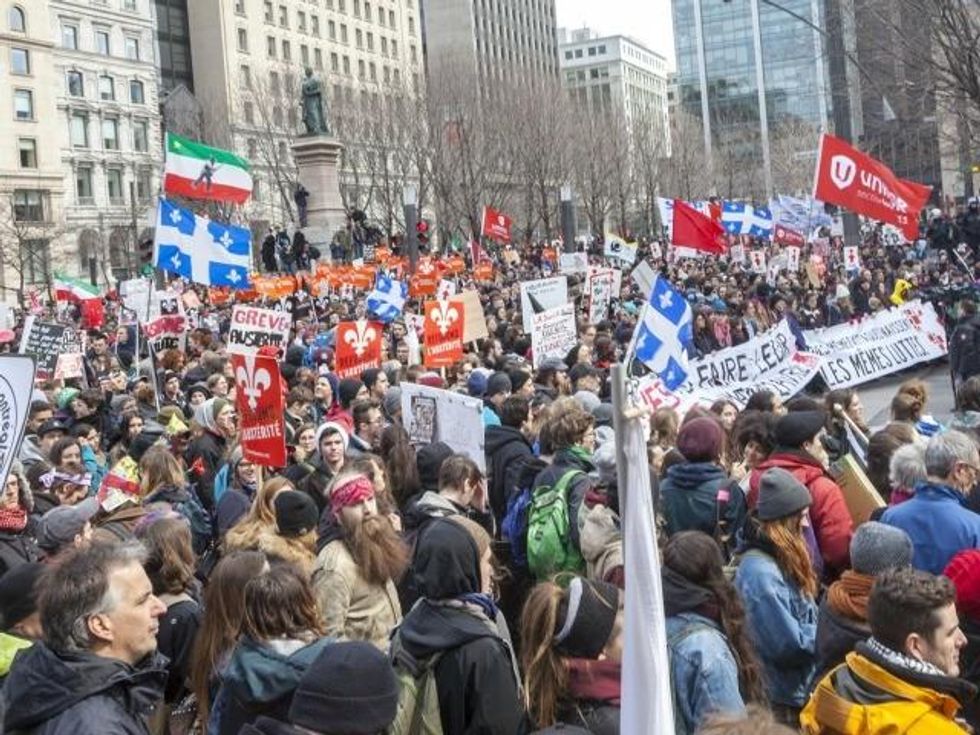
Everyone was dressed for some freakish hybrid of rain and snow, and as the sun broke out layers were shed and smiles broke out. More than anything, this protest felt like a reunion. Since 2012 Quebecers have wondered, can we do it again? Will we remember the way to the square, as they say in Egypt?
As the march surged up University street Quebecois hip-hop, a protest staple with verses which often lionize the student movement, blasted from the speaker truck and the crowd seemed to bounce up and down as one. The air was electric. It was finally spring, and as students shook off the cobwebs of a long, dark winter they began to wonder if maybe, just maybe, they might be able to emerge from the shadow of austerity as well.
Most anger is impotent, and as a result it becomes corrosive. What coursed through the streets yesterday was anger yes, but hopeful anger, empowered with the contagious belief that change is possible. This day was perhaps nothing less than a street party to celebrate the return of our collective anger.
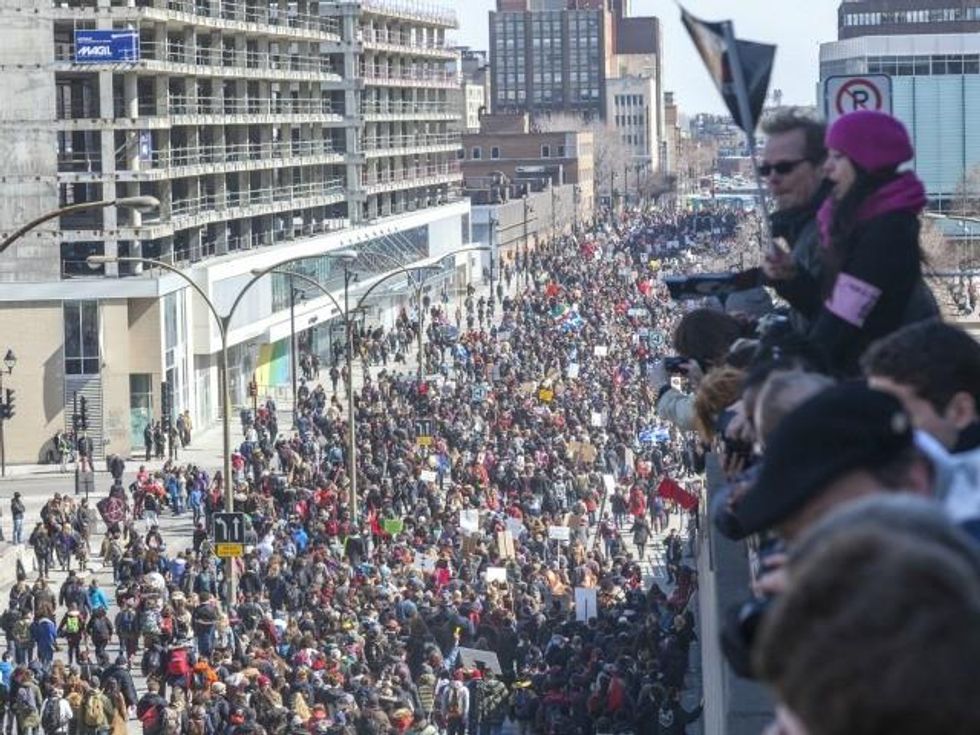
I know that energy. It coursed through the streets of the province in 2012, and it is, without doubt, the strongest political force in Quebec. When the movement is small enough, as it has been since 2012, it can be repressed. But when it brings tens of thousands to the streets the people begin to feel their own power. It's habit forming, even addictive. Yesterday, that collective power ran through the streets like a shock to the city's frozen system.
There's a place in Montreal, an underpass on Berri, where you can get an elevated view of a march for many blocks in both directions. It's become obligatory to pass under it, if for no other reason than to satiate the photographers, but I've always felt it's a bit of a brag from the student movement: pick your vantage point, and we'll fill the street for as far as the eye can see.
As you can see from this time lapse of the crowd passing under the overpass, yesterday's march did not disappoint.
Around three the march arrived at Emilie-Gamelin, the public square of the 2012 student strike. As many of those from out of town boarded buses a contingent of locals set off east on Saint-Catherine street, mingling with traffic and drawing supportive honks from many of the stranded motorists.
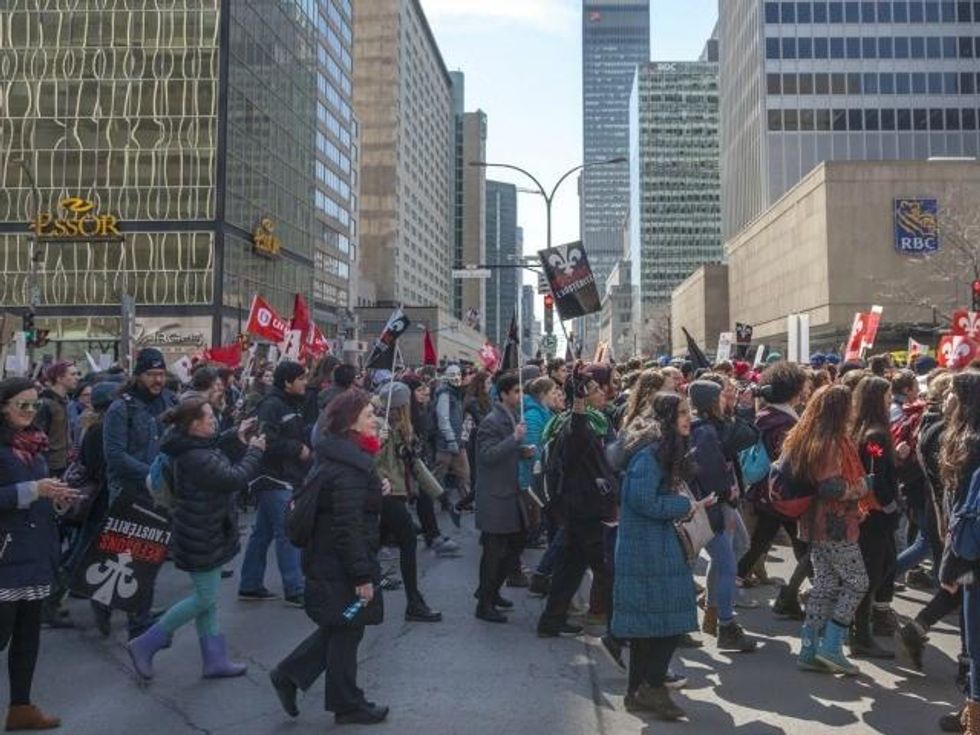
The march turned down a narrow residential street, and the residents came out on balconies and doorsteps to wave at the crowd. I was near a contingent of high school students with a banner, and they were greeted warmly. The crowd briefly shifted the chant to "no justice, no peace. Fuck the police" for perhaps a verse before returning to something else. Moments later, a line of riot cops charged down the narrow street towards the crowd at full speed. If a line like that catches up to you, you go down under batons and the students ran like they knew it.
With nowhere to escape, the charge provoked a stampede down the street towards boulevard Rene-Levesque. As we scrambled out onto the wide boulevard we were met with a volley of tear gas fired in all directions across our path. The gas is incapacitating, searing lungs, eyes and nose on contact and making breathing difficult. The desire to rub your eyes is overpowering, but doing so can cause permanent damage. Some students were treated with field first aid, aka maalox, to the eyes, and the march reassembled and pushed on, flashing peace signs at lines of riot cops.
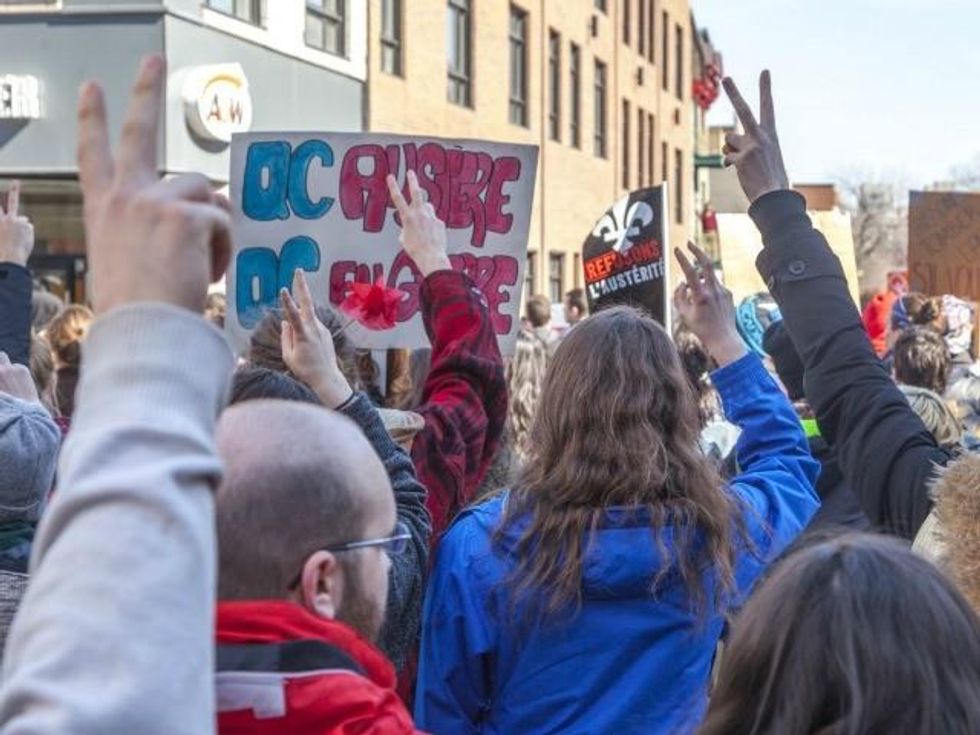
Another, more violent, confrontation reportedly occurred at the intersection of de Maisonneuve and Amherst, where pepper spray, tear gas and batons were used against students. Photographer Toma Iczkovits captured the action shot of the day from that confrontation.
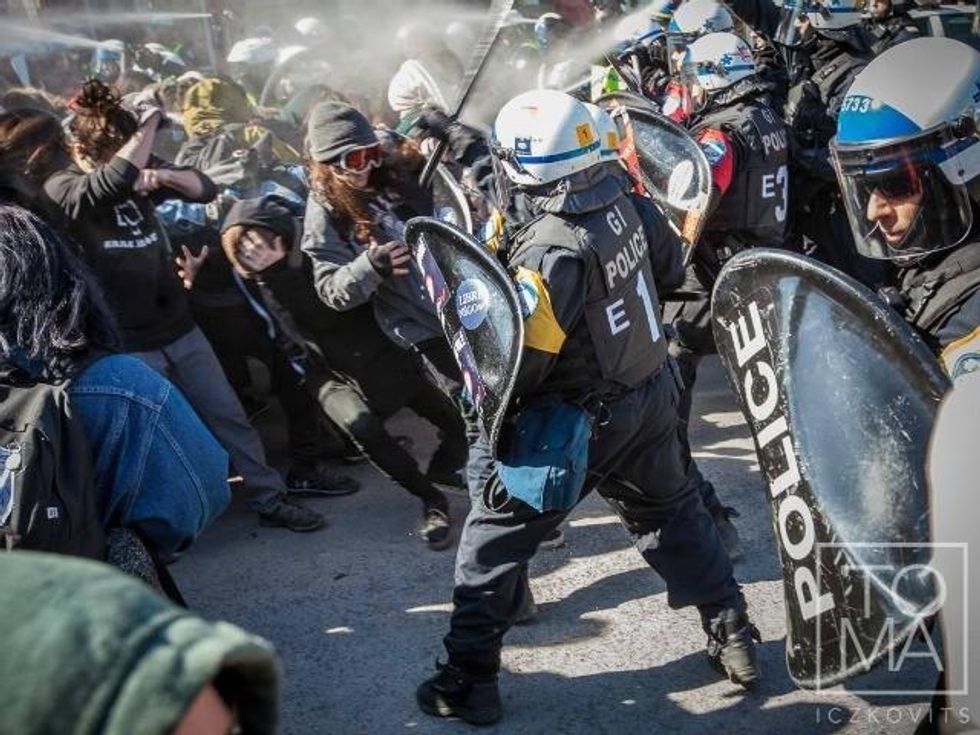
I had forgotten I was close to the contingent of high school students when this happened until the morning, when I opened Facebook and saw a half dozen professionals posting about how their teenage kids had received their first dose of tear gas. Most were proud, if angry at police. Some called it a rite of passage.
If there was any provocation on the part of this peaceful crowd, it was a single verse of a chant which no doubt offends the sensibilities of the police. In response to this they baton charged the protesters, soaking them in tear gas. And at that we got off lucky, compared to the treatment of protesters at smaller demos over the past two weeks. How can it be acceptable to treat peaceful protesters, students, minors even, with this level of aggression at the slightest provocation?
Gabriel Nadeau-Dubois has written on the role of media in reinforcing the brutality of Quebec's police forces, and we translated that piece into English if you want to read it, but the truth is that police likely overplayed their hand last week. Firing a tear gas canister into the face of an 18-year-old student at point blank range was a recruitment video for the movement, and when she emerged from hospital to triumphantly lead a march of thousands of her peers four days later it was a moment approaching the iconic.
For many Quebec students, Naomie Tremblay-Trudeau is an inspiration. She's never said it, but you could caption every photo of her with the words, "I refuse to be afraid." If this tiny teenager refuses to submit to fear of the police, what excuse does anyone else have for doing so?
Video journalist Mario Jean first noted, in his report from the first night demo last week, that the excessive violence had had the opposite of its intended effect. Rather than making protesters fearful, it had exposed the weakness of the police. One cannot exert moral authority over a people whom you are brutalizing.
Students have taken to flashing peace signs, to underline their outrage that police are taking away their right to protest peacefully. But when pushed, when pepper-sprayed and clubbed, lines of students have started pushing back.
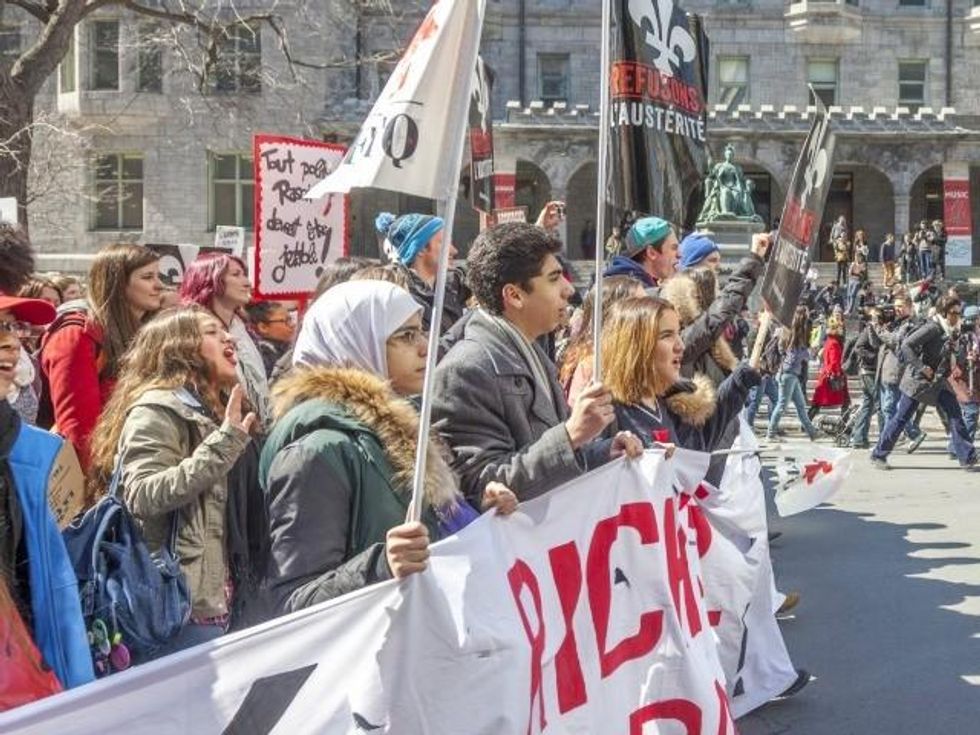
As the protest wound down around four at Emilie-Gamelin, protesters remained in the intersection of de Maisonneuve and Berri. Riot cops made an announcement demanding they go into the nearby park, and they gleefully ignored it. Police decided, for reasons supposedly to do with rush-hour traffic, that they needed to clear the intersection.
So they brought in a bunch of riot cops and boxed protesters out of the intersection. As they tried to do this protesters kept slipping through their lines and dancing around in the centre of the box. They were laughing, and so was everyone watching. Then a couple cops got liberal with their batons and it went from a game to a confrontation in seconds. The riot cops fell back, forming a line to confront the students. Instead of backing down in the face of shields, batons and pepper spray, the students surged forwards. I was at a lot of the demos in 2012, and I swear I've never seen anything like it. They moved like a tidal wave, sweeping the heavily-armoured police line ahead of them against heavy resistance for a good twenty feet, before police retreated and allowed protesters to retake the intersection.
For me, that's the definition of non-violent resistance. Not one hand was raised to a police officer, but the students physically refused to be beaten down or forced from their space. Eventually, after I left, the few stragglers left in the intersection were gassed and driven away, but overall only two arrests were reported, both under the judicially discredited bylaw P-6, and it was a very peaceful day.
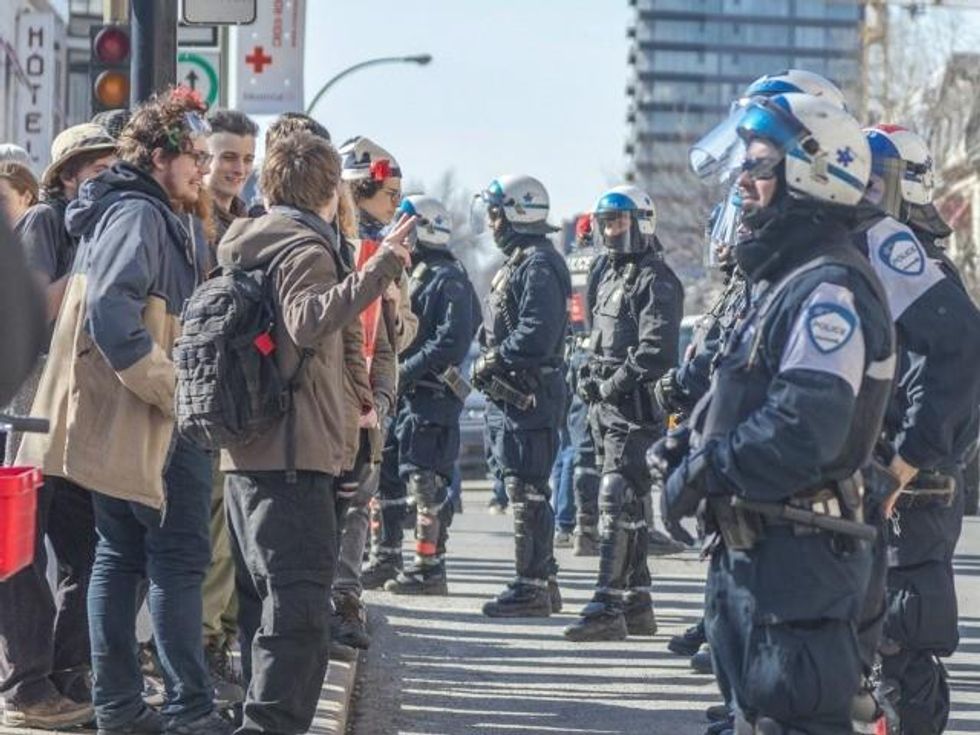
A photo-journalist friend, who made a trip to the hospital of her own last week thanks to a cop's boot, told me she talks to them on the line sometimes, and thinks they are genuinely scared. It's hard to feel sorry for cops when the violence thus far has overwhelmingly been perpetrated by the heavily-armoured professionals with weapons against the unarmed and non-violent students, but just as the media are dehumanizing the protesters, the cops are dehumanizing themselves in the eyes of protesters with these horrific acts.
If you're a student in Quebec right now your idea of the police forces is that they are heavily armed thugs in masks who cause serious bodily injury to you and your friends without provocation. If they come for you, you run, because if they catch you they'll beat you down and it's only a matter of time until someone doesn't get up again. This is what we're teaching our young people about cops, through vicious lessons they won't soon forget.
The more the police brutalize protesters, the more what respect protesters ever held for their authority will evaporate, and students will start fighting back. Few among us are Ghandi. These kids have every right to be out there, and our constitution says so. Who among us, going about their lawful business, would accept regular beatings and gassings by the police?
If Couillard and Coderre have any respect for the fabric of our society, they will rein in the police before they kill someone. Because once they do, and at this rate it's inevitable, the province will explode.
An ASSE congress this weekend will decide the future of the strike, but no matter what happens this spring, this fall could see the largest social conflict in the history of Quebec.
Observers expect the ASSE to pull back from unlimited strike action this spring and prepare a summer-long campaign to begin a full general strike later this year. They hope that public sector unions, who have a legal window to strike in the fall, will join them in a common front against the austerity government. If they do, the combined weight of a fully mobilized labour movement joining forces with the student movement will make 2012 look like a practice run.
The labour movement has traditionally been hesitant to engage in an unlimited strike, but with austerity hitting their members hard the circumstances may have changed.
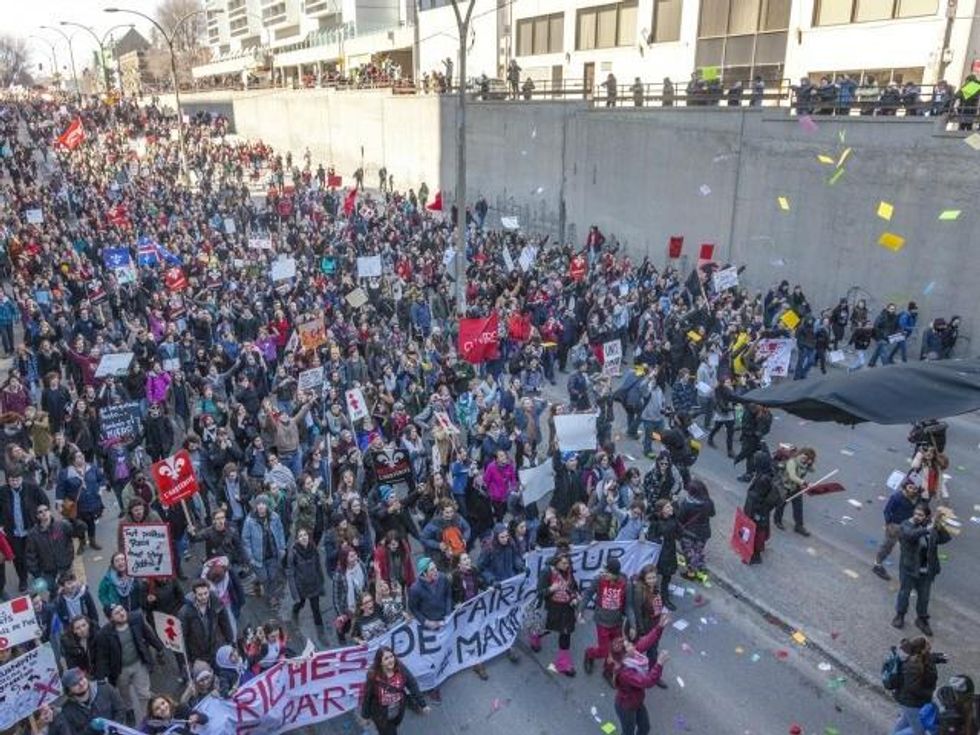
As for the students, they sent a clear message on Thursday: we are mobilized, we are many, and we are not afraid. Whether now or next fall, we will meet you in the streets and we will stop you.
All indications point to a major showdown at some point in 2015, one which could have implications for the austerity agenda on a global scale. Whatever happens, we'll be here to cover it.
Political revenge. Mass deportations. Project 2025. Unfathomable corruption. Attacks on Social Security, Medicare, and Medicaid. Pardons for insurrectionists. An all-out assault on democracy. Republicans in Congress are scrambling to give Trump broad new powers to strip the tax-exempt status of any nonprofit he doesn’t like by declaring it a “terrorist-supporting organization.” Trump has already begun filing lawsuits against news outlets that criticize him. At Common Dreams, we won’t back down, but we must get ready for whatever Trump and his thugs throw at us. Our Year-End campaign is our most important fundraiser of the year. As a people-powered nonprofit news outlet, we cover issues the corporate media never will, but we can only continue with our readers’ support. By donating today, please help us fight the dangers of a second Trump presidency. |
The weather report had called for "snow/rain," but instead the clouds parted and the largest demonstration in Quebec since the student strike of 2012 was bathed in the sunny glow of springtime in Montreal.
In Square Victoria, a park in the heart of Montreal's financial district, each metro brought a new surge of people and the place was soon packed, with the crowd overflowing into several side streets.
Over 130,000 students were on strike across Quebec on Apr. 2, and according to the Association pour une solidarite syndicale etudiante, the crowd in Montreal reached around 75,000 at its peak. Based on my calculations, that's a reasonable estimate. Other media outlets reported a number of 25,000, attributing it to police scanners, but that may have been prior to the demonstration's peak.
* VIDEO: #Manif2Avril, the fight against austerity in pictures
* EXPLAINER: Will Quebec's student movement opt for a spring strike or a strategic fallback?
Alongside students there was a strong labour presence, with public sector employees joining Montreal's firefighters, labour federation Confederation des syndicats nationaux and dozens of other unions in the streets. McGill University's law department was on strike for the first time in the history of that institution, and their banner was greeted with cheers wherever it went.
Nine student leaders are currently facing expulsion for strike-related activities at Universite du Quebec a Montreal, and the teachers' union there also went on strike for the day, the faculty of that institution sending a strong message by joining their students in the streets.
Throughout the morning a steady stream of buses rolled in, bringing students and activists alike from places like Rimouski, Quebec City, Saguenay, Levis and points beyond. By the time the march departed, the square was packed, and new arrivals continued to replace those departing for at least another half hour.

Everyone was dressed for some freakish hybrid of rain and snow, and as the sun broke out layers were shed and smiles broke out. More than anything, this protest felt like a reunion. Since 2012 Quebecers have wondered, can we do it again? Will we remember the way to the square, as they say in Egypt?
As the march surged up University street Quebecois hip-hop, a protest staple with verses which often lionize the student movement, blasted from the speaker truck and the crowd seemed to bounce up and down as one. The air was electric. It was finally spring, and as students shook off the cobwebs of a long, dark winter they began to wonder if maybe, just maybe, they might be able to emerge from the shadow of austerity as well.
Most anger is impotent, and as a result it becomes corrosive. What coursed through the streets yesterday was anger yes, but hopeful anger, empowered with the contagious belief that change is possible. This day was perhaps nothing less than a street party to celebrate the return of our collective anger.

I know that energy. It coursed through the streets of the province in 2012, and it is, without doubt, the strongest political force in Quebec. When the movement is small enough, as it has been since 2012, it can be repressed. But when it brings tens of thousands to the streets the people begin to feel their own power. It's habit forming, even addictive. Yesterday, that collective power ran through the streets like a shock to the city's frozen system.
There's a place in Montreal, an underpass on Berri, where you can get an elevated view of a march for many blocks in both directions. It's become obligatory to pass under it, if for no other reason than to satiate the photographers, but I've always felt it's a bit of a brag from the student movement: pick your vantage point, and we'll fill the street for as far as the eye can see.
As you can see from this time lapse of the crowd passing under the overpass, yesterday's march did not disappoint.
Around three the march arrived at Emilie-Gamelin, the public square of the 2012 student strike. As many of those from out of town boarded buses a contingent of locals set off east on Saint-Catherine street, mingling with traffic and drawing supportive honks from many of the stranded motorists.

The march turned down a narrow residential street, and the residents came out on balconies and doorsteps to wave at the crowd. I was near a contingent of high school students with a banner, and they were greeted warmly. The crowd briefly shifted the chant to "no justice, no peace. Fuck the police" for perhaps a verse before returning to something else. Moments later, a line of riot cops charged down the narrow street towards the crowd at full speed. If a line like that catches up to you, you go down under batons and the students ran like they knew it.
With nowhere to escape, the charge provoked a stampede down the street towards boulevard Rene-Levesque. As we scrambled out onto the wide boulevard we were met with a volley of tear gas fired in all directions across our path. The gas is incapacitating, searing lungs, eyes and nose on contact and making breathing difficult. The desire to rub your eyes is overpowering, but doing so can cause permanent damage. Some students were treated with field first aid, aka maalox, to the eyes, and the march reassembled and pushed on, flashing peace signs at lines of riot cops.

Another, more violent, confrontation reportedly occurred at the intersection of de Maisonneuve and Amherst, where pepper spray, tear gas and batons were used against students. Photographer Toma Iczkovits captured the action shot of the day from that confrontation.

I had forgotten I was close to the contingent of high school students when this happened until the morning, when I opened Facebook and saw a half dozen professionals posting about how their teenage kids had received their first dose of tear gas. Most were proud, if angry at police. Some called it a rite of passage.
If there was any provocation on the part of this peaceful crowd, it was a single verse of a chant which no doubt offends the sensibilities of the police. In response to this they baton charged the protesters, soaking them in tear gas. And at that we got off lucky, compared to the treatment of protesters at smaller demos over the past two weeks. How can it be acceptable to treat peaceful protesters, students, minors even, with this level of aggression at the slightest provocation?
Gabriel Nadeau-Dubois has written on the role of media in reinforcing the brutality of Quebec's police forces, and we translated that piece into English if you want to read it, but the truth is that police likely overplayed their hand last week. Firing a tear gas canister into the face of an 18-year-old student at point blank range was a recruitment video for the movement, and when she emerged from hospital to triumphantly lead a march of thousands of her peers four days later it was a moment approaching the iconic.
For many Quebec students, Naomie Tremblay-Trudeau is an inspiration. She's never said it, but you could caption every photo of her with the words, "I refuse to be afraid." If this tiny teenager refuses to submit to fear of the police, what excuse does anyone else have for doing so?
Video journalist Mario Jean first noted, in his report from the first night demo last week, that the excessive violence had had the opposite of its intended effect. Rather than making protesters fearful, it had exposed the weakness of the police. One cannot exert moral authority over a people whom you are brutalizing.
Students have taken to flashing peace signs, to underline their outrage that police are taking away their right to protest peacefully. But when pushed, when pepper-sprayed and clubbed, lines of students have started pushing back.

As the protest wound down around four at Emilie-Gamelin, protesters remained in the intersection of de Maisonneuve and Berri. Riot cops made an announcement demanding they go into the nearby park, and they gleefully ignored it. Police decided, for reasons supposedly to do with rush-hour traffic, that they needed to clear the intersection.
So they brought in a bunch of riot cops and boxed protesters out of the intersection. As they tried to do this protesters kept slipping through their lines and dancing around in the centre of the box. They were laughing, and so was everyone watching. Then a couple cops got liberal with their batons and it went from a game to a confrontation in seconds. The riot cops fell back, forming a line to confront the students. Instead of backing down in the face of shields, batons and pepper spray, the students surged forwards. I was at a lot of the demos in 2012, and I swear I've never seen anything like it. They moved like a tidal wave, sweeping the heavily-armoured police line ahead of them against heavy resistance for a good twenty feet, before police retreated and allowed protesters to retake the intersection.
For me, that's the definition of non-violent resistance. Not one hand was raised to a police officer, but the students physically refused to be beaten down or forced from their space. Eventually, after I left, the few stragglers left in the intersection were gassed and driven away, but overall only two arrests were reported, both under the judicially discredited bylaw P-6, and it was a very peaceful day.

A photo-journalist friend, who made a trip to the hospital of her own last week thanks to a cop's boot, told me she talks to them on the line sometimes, and thinks they are genuinely scared. It's hard to feel sorry for cops when the violence thus far has overwhelmingly been perpetrated by the heavily-armoured professionals with weapons against the unarmed and non-violent students, but just as the media are dehumanizing the protesters, the cops are dehumanizing themselves in the eyes of protesters with these horrific acts.
If you're a student in Quebec right now your idea of the police forces is that they are heavily armed thugs in masks who cause serious bodily injury to you and your friends without provocation. If they come for you, you run, because if they catch you they'll beat you down and it's only a matter of time until someone doesn't get up again. This is what we're teaching our young people about cops, through vicious lessons they won't soon forget.
The more the police brutalize protesters, the more what respect protesters ever held for their authority will evaporate, and students will start fighting back. Few among us are Ghandi. These kids have every right to be out there, and our constitution says so. Who among us, going about their lawful business, would accept regular beatings and gassings by the police?
If Couillard and Coderre have any respect for the fabric of our society, they will rein in the police before they kill someone. Because once they do, and at this rate it's inevitable, the province will explode.
An ASSE congress this weekend will decide the future of the strike, but no matter what happens this spring, this fall could see the largest social conflict in the history of Quebec.
Observers expect the ASSE to pull back from unlimited strike action this spring and prepare a summer-long campaign to begin a full general strike later this year. They hope that public sector unions, who have a legal window to strike in the fall, will join them in a common front against the austerity government. If they do, the combined weight of a fully mobilized labour movement joining forces with the student movement will make 2012 look like a practice run.
The labour movement has traditionally been hesitant to engage in an unlimited strike, but with austerity hitting their members hard the circumstances may have changed.

As for the students, they sent a clear message on Thursday: we are mobilized, we are many, and we are not afraid. Whether now or next fall, we will meet you in the streets and we will stop you.
All indications point to a major showdown at some point in 2015, one which could have implications for the austerity agenda on a global scale. Whatever happens, we'll be here to cover it.
The weather report had called for "snow/rain," but instead the clouds parted and the largest demonstration in Quebec since the student strike of 2012 was bathed in the sunny glow of springtime in Montreal.
In Square Victoria, a park in the heart of Montreal's financial district, each metro brought a new surge of people and the place was soon packed, with the crowd overflowing into several side streets.
Over 130,000 students were on strike across Quebec on Apr. 2, and according to the Association pour une solidarite syndicale etudiante, the crowd in Montreal reached around 75,000 at its peak. Based on my calculations, that's a reasonable estimate. Other media outlets reported a number of 25,000, attributing it to police scanners, but that may have been prior to the demonstration's peak.
* VIDEO: #Manif2Avril, the fight against austerity in pictures
* EXPLAINER: Will Quebec's student movement opt for a spring strike or a strategic fallback?
Alongside students there was a strong labour presence, with public sector employees joining Montreal's firefighters, labour federation Confederation des syndicats nationaux and dozens of other unions in the streets. McGill University's law department was on strike for the first time in the history of that institution, and their banner was greeted with cheers wherever it went.
Nine student leaders are currently facing expulsion for strike-related activities at Universite du Quebec a Montreal, and the teachers' union there also went on strike for the day, the faculty of that institution sending a strong message by joining their students in the streets.
Throughout the morning a steady stream of buses rolled in, bringing students and activists alike from places like Rimouski, Quebec City, Saguenay, Levis and points beyond. By the time the march departed, the square was packed, and new arrivals continued to replace those departing for at least another half hour.

Everyone was dressed for some freakish hybrid of rain and snow, and as the sun broke out layers were shed and smiles broke out. More than anything, this protest felt like a reunion. Since 2012 Quebecers have wondered, can we do it again? Will we remember the way to the square, as they say in Egypt?
As the march surged up University street Quebecois hip-hop, a protest staple with verses which often lionize the student movement, blasted from the speaker truck and the crowd seemed to bounce up and down as one. The air was electric. It was finally spring, and as students shook off the cobwebs of a long, dark winter they began to wonder if maybe, just maybe, they might be able to emerge from the shadow of austerity as well.
Most anger is impotent, and as a result it becomes corrosive. What coursed through the streets yesterday was anger yes, but hopeful anger, empowered with the contagious belief that change is possible. This day was perhaps nothing less than a street party to celebrate the return of our collective anger.

I know that energy. It coursed through the streets of the province in 2012, and it is, without doubt, the strongest political force in Quebec. When the movement is small enough, as it has been since 2012, it can be repressed. But when it brings tens of thousands to the streets the people begin to feel their own power. It's habit forming, even addictive. Yesterday, that collective power ran through the streets like a shock to the city's frozen system.
There's a place in Montreal, an underpass on Berri, where you can get an elevated view of a march for many blocks in both directions. It's become obligatory to pass under it, if for no other reason than to satiate the photographers, but I've always felt it's a bit of a brag from the student movement: pick your vantage point, and we'll fill the street for as far as the eye can see.
As you can see from this time lapse of the crowd passing under the overpass, yesterday's march did not disappoint.
Around three the march arrived at Emilie-Gamelin, the public square of the 2012 student strike. As many of those from out of town boarded buses a contingent of locals set off east on Saint-Catherine street, mingling with traffic and drawing supportive honks from many of the stranded motorists.

The march turned down a narrow residential street, and the residents came out on balconies and doorsteps to wave at the crowd. I was near a contingent of high school students with a banner, and they were greeted warmly. The crowd briefly shifted the chant to "no justice, no peace. Fuck the police" for perhaps a verse before returning to something else. Moments later, a line of riot cops charged down the narrow street towards the crowd at full speed. If a line like that catches up to you, you go down under batons and the students ran like they knew it.
With nowhere to escape, the charge provoked a stampede down the street towards boulevard Rene-Levesque. As we scrambled out onto the wide boulevard we were met with a volley of tear gas fired in all directions across our path. The gas is incapacitating, searing lungs, eyes and nose on contact and making breathing difficult. The desire to rub your eyes is overpowering, but doing so can cause permanent damage. Some students were treated with field first aid, aka maalox, to the eyes, and the march reassembled and pushed on, flashing peace signs at lines of riot cops.

Another, more violent, confrontation reportedly occurred at the intersection of de Maisonneuve and Amherst, where pepper spray, tear gas and batons were used against students. Photographer Toma Iczkovits captured the action shot of the day from that confrontation.

I had forgotten I was close to the contingent of high school students when this happened until the morning, when I opened Facebook and saw a half dozen professionals posting about how their teenage kids had received their first dose of tear gas. Most were proud, if angry at police. Some called it a rite of passage.
If there was any provocation on the part of this peaceful crowd, it was a single verse of a chant which no doubt offends the sensibilities of the police. In response to this they baton charged the protesters, soaking them in tear gas. And at that we got off lucky, compared to the treatment of protesters at smaller demos over the past two weeks. How can it be acceptable to treat peaceful protesters, students, minors even, with this level of aggression at the slightest provocation?
Gabriel Nadeau-Dubois has written on the role of media in reinforcing the brutality of Quebec's police forces, and we translated that piece into English if you want to read it, but the truth is that police likely overplayed their hand last week. Firing a tear gas canister into the face of an 18-year-old student at point blank range was a recruitment video for the movement, and when she emerged from hospital to triumphantly lead a march of thousands of her peers four days later it was a moment approaching the iconic.
For many Quebec students, Naomie Tremblay-Trudeau is an inspiration. She's never said it, but you could caption every photo of her with the words, "I refuse to be afraid." If this tiny teenager refuses to submit to fear of the police, what excuse does anyone else have for doing so?
Video journalist Mario Jean first noted, in his report from the first night demo last week, that the excessive violence had had the opposite of its intended effect. Rather than making protesters fearful, it had exposed the weakness of the police. One cannot exert moral authority over a people whom you are brutalizing.
Students have taken to flashing peace signs, to underline their outrage that police are taking away their right to protest peacefully. But when pushed, when pepper-sprayed and clubbed, lines of students have started pushing back.

As the protest wound down around four at Emilie-Gamelin, protesters remained in the intersection of de Maisonneuve and Berri. Riot cops made an announcement demanding they go into the nearby park, and they gleefully ignored it. Police decided, for reasons supposedly to do with rush-hour traffic, that they needed to clear the intersection.
So they brought in a bunch of riot cops and boxed protesters out of the intersection. As they tried to do this protesters kept slipping through their lines and dancing around in the centre of the box. They were laughing, and so was everyone watching. Then a couple cops got liberal with their batons and it went from a game to a confrontation in seconds. The riot cops fell back, forming a line to confront the students. Instead of backing down in the face of shields, batons and pepper spray, the students surged forwards. I was at a lot of the demos in 2012, and I swear I've never seen anything like it. They moved like a tidal wave, sweeping the heavily-armoured police line ahead of them against heavy resistance for a good twenty feet, before police retreated and allowed protesters to retake the intersection.
For me, that's the definition of non-violent resistance. Not one hand was raised to a police officer, but the students physically refused to be beaten down or forced from their space. Eventually, after I left, the few stragglers left in the intersection were gassed and driven away, but overall only two arrests were reported, both under the judicially discredited bylaw P-6, and it was a very peaceful day.

A photo-journalist friend, who made a trip to the hospital of her own last week thanks to a cop's boot, told me she talks to them on the line sometimes, and thinks they are genuinely scared. It's hard to feel sorry for cops when the violence thus far has overwhelmingly been perpetrated by the heavily-armoured professionals with weapons against the unarmed and non-violent students, but just as the media are dehumanizing the protesters, the cops are dehumanizing themselves in the eyes of protesters with these horrific acts.
If you're a student in Quebec right now your idea of the police forces is that they are heavily armed thugs in masks who cause serious bodily injury to you and your friends without provocation. If they come for you, you run, because if they catch you they'll beat you down and it's only a matter of time until someone doesn't get up again. This is what we're teaching our young people about cops, through vicious lessons they won't soon forget.
The more the police brutalize protesters, the more what respect protesters ever held for their authority will evaporate, and students will start fighting back. Few among us are Ghandi. These kids have every right to be out there, and our constitution says so. Who among us, going about their lawful business, would accept regular beatings and gassings by the police?
If Couillard and Coderre have any respect for the fabric of our society, they will rein in the police before they kill someone. Because once they do, and at this rate it's inevitable, the province will explode.
An ASSE congress this weekend will decide the future of the strike, but no matter what happens this spring, this fall could see the largest social conflict in the history of Quebec.
Observers expect the ASSE to pull back from unlimited strike action this spring and prepare a summer-long campaign to begin a full general strike later this year. They hope that public sector unions, who have a legal window to strike in the fall, will join them in a common front against the austerity government. If they do, the combined weight of a fully mobilized labour movement joining forces with the student movement will make 2012 look like a practice run.
The labour movement has traditionally been hesitant to engage in an unlimited strike, but with austerity hitting their members hard the circumstances may have changed.

As for the students, they sent a clear message on Thursday: we are mobilized, we are many, and we are not afraid. Whether now or next fall, we will meet you in the streets and we will stop you.
All indications point to a major showdown at some point in 2015, one which could have implications for the austerity agenda on a global scale. Whatever happens, we'll be here to cover it.